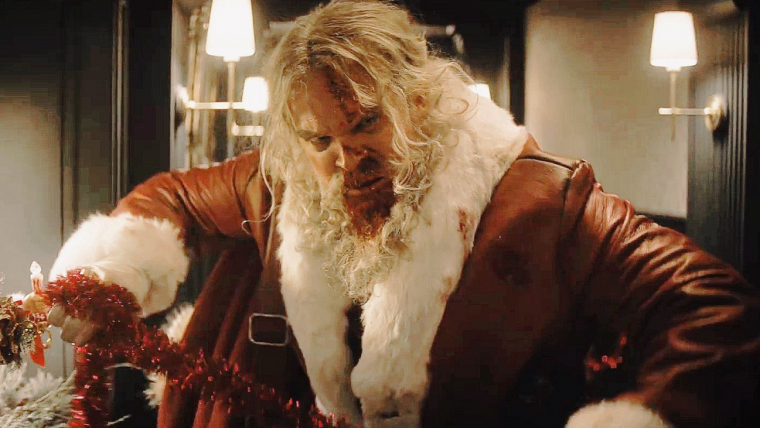
David Harbour in Violent Night
VIOLENT NIGHT
Before discussing the very, very Bad Santa at the heart of director Tommy Wirkola's Violent Night, I want to address this grisly action comedy's other heroic perpetrator of bloody mayhem. Because despite the commitment that David Harbour lends to his portrayal of a jolly old elf by way of The Northman, seven-year-old Trudy Lightstone (endearingly enacted by Leah Brady) is easily the film's more interesting figure, largely for being the only movie character I can think of to truly call out the insidious irresponsibility in that holiday “classic” Home Alone.
I know, I know. That seasonal slapstick isn't the sort of thing to get riled up about. And besides, you love it, right? So do your kids, and maybe your grandkids, too. That adorable ragamuffin Kevin McCallister making friends with his misunderstood next-door neighbor! Kevin asking Santa to bring his family home for Christmas! Macaulay Culkin shrieking! And isn't it hysterical when Kevin sets all those booby traps for Joe Pesci's and Daniel's Stern's home burglars? The ones involving blow torches and hurled bricks and spine-cracking falls that, in the real world, would leave those hapless bad guys comatose quadriplegics at best and dead at worst?
It was always clear what director Chris Columbus and screenwriter John Hughes were going for: a live-action take on those hilariously brutal Looney Tunes shorts in which, say, Daffy Duck would endure six minutes of gunfire to the face, or Wile E. Coyote would survive a fall from the Grand Canyon followed by an Acme anvil dropping on his head. But as a 22-year-old in 1990 watching Home Alone for the first (and last) time, Columbus' and Hughes' slapstick plan seemed utterly repellant to me. Mister Rogers did an episode explaining to children why they shouldn't jump off the rooftop in a cape and expect to fly like Superman. Yet where was the voice of reason telling little kids to not shoot people in the groin with a BB gun or make their parents tumble to the floor on their Micro Machines? By refusing to acknowledge that Kevin's actions toward fresh-and-blood humans had flesh-and-blood consequences, Home Alone made sadism, for an easily impressionable demographic, look like a blast.
In the presence of Violent Night's Trudy, I'm happy to say, it appears that a movie finally gets me on this issue. Trudy's big scene comes late in the film, after her grandmother's house has been invaded by a team of vicious mercenaries in search of hundreds of millions in cash. After killing the staff, the bad guys begin inflicting their cruelty on Trudy's relatives, and the tyke scrambles off to the attic, where she's fortunate enough to share walkie-talkie communication with Santa himself. Harbour's Saint Nick tells the girl that he's on the way and advises her to stay hidden. But based on Trudy's early mention of having just seen and loved Home Alone, to say nothing of the excessive comic savagery of Wirkola's film to this point, we know that hiding won't be on her agenda – not when she can instead Macaulay Culkin her way out of danger.
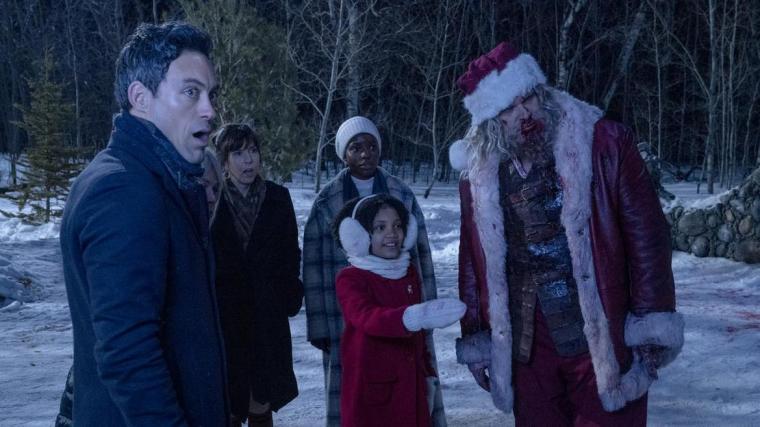
If you've seen Violent Night's trailers, or even its poster, you'll know just what to expect: everyone's favorite lumpy bad-ass David Harbour as a profane, drunken, vengeful Santa Claus (and former Nordic Viking!) who reclaims his yuletide spirit by saving a little girl on his Nice list and dispensing with the armed goons on his Naughty one. And some of the splatter did, I'll admit, tickle me, particularly the bits involving the wood chipper and the execution of the mercenaries' most lethal foe through gory means I wouldn't dream of spoiling. But for my money, the only sequence that boasted truly sustained comic wit was Trudy's defense of her attic retreat, because while the seven-year-old may not necessarily have registered the extent of the physical suffering she was inflicting – she may even have delivered a Culkin-esque fist pump for her cleverness – we sure as hell do.
In the gender-biased manner of nearly every action flick ever made, it's up to Trudy to square off against the villainous brigade's one female assailant (Mitra Suri), and employing a miniature trampoline as a launchpad, the kid does quite a bit of obvious damage to the woman's cranium – also subjecting her to the Hughes-devised sticky-floor conundrum – before Santa belatedly arrives. (Sweet elf that he is, the guy insists that Trudy turn her back and cover her ears before finishing the job.) This mercenary, however, almost gets off lucky compared to the fate that befalls her partner, who winds up on the receiving end of Home Alone's rigged-ladder gag, its exposed-nail gag, and one of its many heavy-objects-to-the-face gags. This dude's comeuppance is riotous and obscene, and effectively demolishes that bloodless, unfunny lie behind the relentlessly barbaric treatment of Pesci's and Stern's burglars. Turns out that a bowling ball landing on your head from a great height won't simply bounce off with a satisfying “Bonk!” It's more apt to crush your skull in. Who knew?!
If I've spent an inordinate amount of wordage on the Home Alone-iness of Wirkola's movie, that's mostly because I really don't have much to say about the rest of it. Harbour is solid, as we knew he'd be; the hateful villains (even John Leguizamo's ringleader) are as interchangeable as we suspected they'd be; the internally warring family members who need to be saved – with the possible exception of Beverly D'Angelo's venom-spewing, whiskey-voiced matriarch – are the anticipated levels of bland. Given that there's nothing close to subtlety in sight, you have to let the occasionally amusing, routinely gruesome Violent Night do all the work for you. Agree to its terms, though, and the film is 110 minutes of intermittent fun, complete with previously unimagined uses for strings of Christmas lights, snow blowers, and electrically illuminated tree toppers. To quote Macaulay: “A-a-a-a-a-a-a!!!”
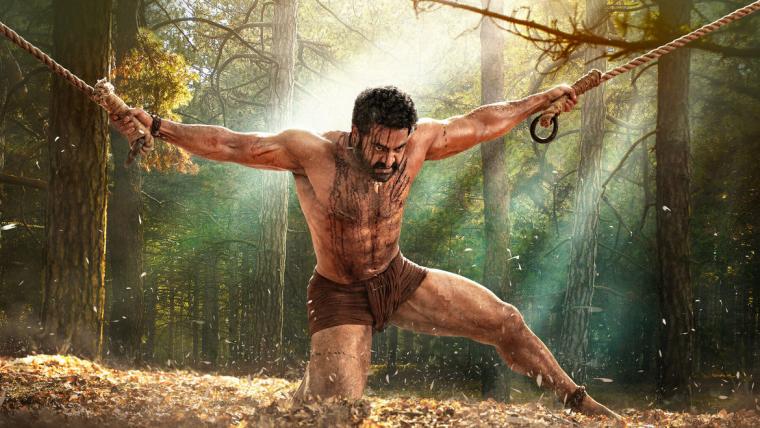
RRR, SR., STUTZ, CAUSEWAY, and ALL QUIET ON THE WESTERN FRONT
As a lifelong film lover and devoted Oscar hound, no month during the calendar year gets me quite as stoked as December, when lingering questions are finally answered (“Will Avatar 2 be worth the generation-long wait?”), guild and critics groups begin narrowing the field of likely Academy Award nominees (“Will anyone remember Mia Goth in Pearl?”), and I'm finally able to catch up with streaming options I've been sleeping on. So before the annual cineplex glut of Christmas-weekend releases hits, let's do some brief(-ish) takes on a number of titles – most of them weeks or months old – that I've recently gotten around to.
The longest-active film-critics society in America, founded way back in 1935, the New York Film Critics Circle announced what I thought was an atypically excellent-across-the-board list of winners this past Friday, awarding Best Picture and Actress to TÁR and leading lady Cate Blanchett; Screenplay and Actor to The Banshees of Inisherin and its star Colin Farrell (who was also cited for the unseen-by-me After Yang, which is now streaming on a number of services – it's on my list!); Supporting Actor to Everything Everywhere All at Once's Ke Huy Quan; Supporting Actress to Nope's Keke Palmer (an inarguable lead performance … at least in theory …); and Animated Feature to Marcel the Shell with Shoes On. All of those movies and performances I don't just like, but love. And then the NYFCC went and threw a wrench into my perfect happiness, and made me feel negligent besides, by naming S.S. Rajamouli Best Director for RRR, the springtime Indian crossover smash that became a Netflix hit in June that I still didn't bother to previously watch. Obviously, despite my initial resistance – it's an action-vengeance-fantasy-bromance-musical running three hours and 10 minutes, for Pete's sake! – I had to rectify that. I'm now deliriously glad that I did.
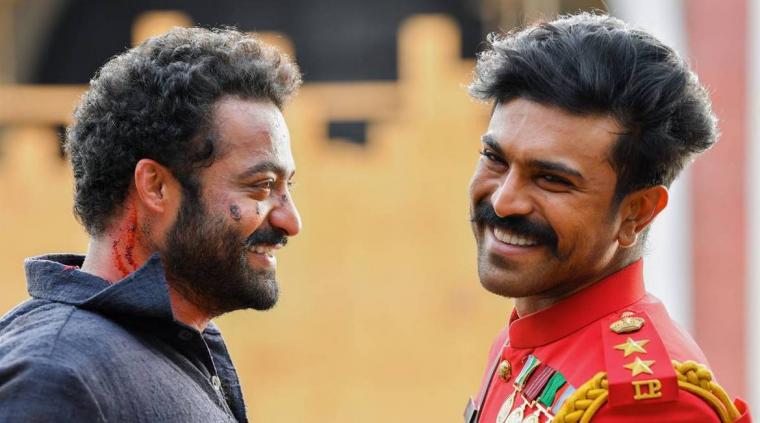
Admittedly, it took some time to cement my delight. A title card at the very beginning explains that no animals were harmed in the making of Rajamoudi's movie, and that these creatures were, in fact, products of CGI. No kidding! For a significant stretch, I couldn't get over the distractingly obvious computer-generation and green-screen effects that were practically parodies of green-screen effects, and the set pieces, emotions, reactions, fight choreography, et al were all so intentionally overscaled (like Michael Bay with a better sense of humor but absolutely no filter) that I didn't know what to make of RRR.
Yet the ridiculous grandiosity – the sheer, broad, gloriously alive make-believe quality of it all – gradually won me over, as did the simple yet internally complex storyline involving best buds (N.T. Rama Rao Jr.'s tribal leader Komaram Bheem and Ram Charan's revolutionary Allun Sitarama Raju) who discover late in the game that they're supposed to be mortal enemies. And when, at the one-hour mark, these two led a massive, nearly surreal group dance-off looking as joyous as movie stars have ever looked, it took all my resistance not to weep and applaud from the confines of my living room. I'm still not sure that Rajamoudi's spectacularly ballsy achievement merits its 190-minute length. But it's thrilling and weird and hugely satisfying, and the chemistry between Rao and Raju is palpable, and it's one of the crowd-pleasing-est crowd-pleasers I've seen all year – and I didn't even need a crowd to glean that. Sadly, RRR has no hope of a Best International Feature Oscar nomination, as India chose not to submit the film for that prize. But if some simpering ballad manages to win the Best Original Song Oscar this year over the divinely raucous pleasure that is “Naatu Naatu,” the Academy and I are gonna have words.
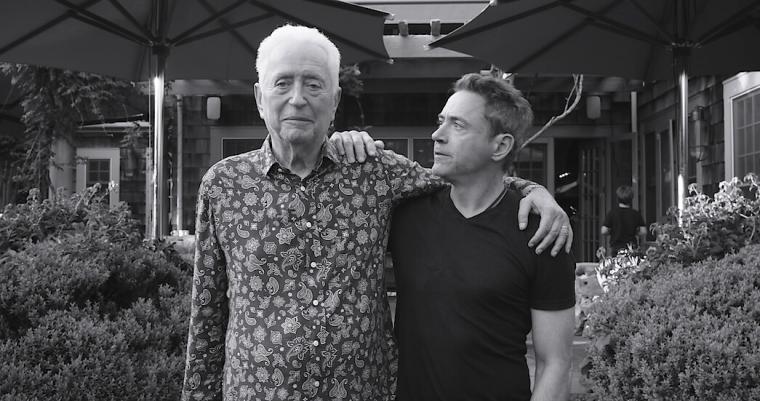
One Netflix streamer that I actually did get to on time was this past weekend's debut of director Chris Smith's Sr., a primarily black-and-white documentary in which Robert Downey Jr. pays tribute to his famed-filmmaker father's works and, more specifically, his late father himself. There's a lot of fascinating footage, if not much in the way of insight, involving Downey Sr.'s directorial credits (1969's Putney Swope being his most recognizable title among dozens of underground and ill-remembered works), given that Dad – from his early talk-show appearances through the interviews given near his 2021 passing – doesn't appear remotely interested in documenting the history of his achievements. But he appears very interested, grateful even, to be spending so much time with his junior namesake, and Smith's doc works beautifully and best as a cinematic love letter from an adult son to his dying father.
Parallels are made, as they should be, between the elder Downey's hedonistic drug use and the younger Downey's later, much-documented drug battles. What most struck me about the movie, however, was how small, how child-like, Downey Jr. seemed whenever his father scooped him into an embrace or riveted his child's attention when he was hospitalized and COVID protocols prevented Jr. from physical contact with his pop. You may not learn a lot about Robert Downey Sr.'s ethos and technique from Sr. Yet you will be witness to an extraordinary bond formed between two Downeys who loved each other deeply, and likely moved by how this man – this Iron Man – whom we feel we know is, like many of us, a helpless, frightened, grateful kid in a parent's presence. Smith's film gives long-delayed human context to the idea of “Robert Downey Sr.” Miraculously, and unexpectedly, it gives human context to the idea of “Robert Downey Jr.” even more.
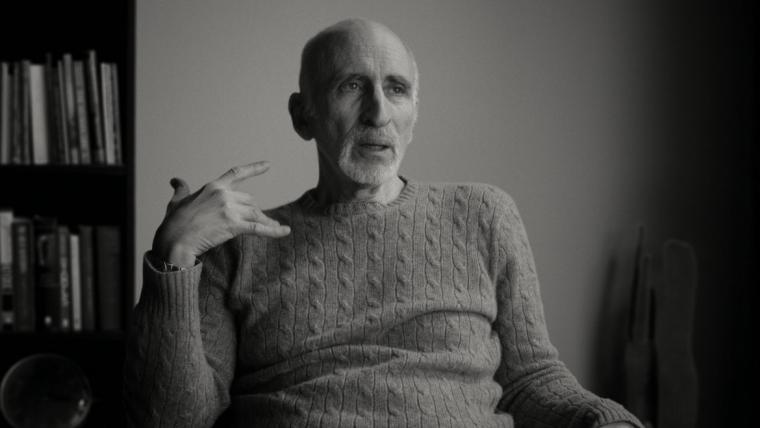
One wouldn't think that an achievement of Sr.'s sort could be easily replicated. Yet it turns out that, unintentionally, Jonah Hill has replicated it, right down to its documentary format, black-and-white photography, deep dives into the past, two central protagonists enacting a father-son dynamic, one-word title starting with “S,” and autumnal release on Netflix. Hill's doc is Stutz, it was released on the streaming service about three weeks ago, and it's named after Hill's real-life therapist Dr. Phil Stutz. In director Hill's work that's designed to resemble a legitimate therapy session, I can't say that I was wowed by the doctor's insights in regard to treating Hill's self-admitted panic attacks that have apparently consumed him for the better part of a decade. Stutz's suggestions for self-help seemed both remedial and a little New Age-y for me – perhaps only because I've spent 54 years not in a therapist's office. (Most therapists, I'm sure, would probably argue that I'm due.) Yet while, like Spielberg's The Fabelmans, this movie might have had more benefit as one that its creator could watch repeatedly without the public ever getting involved, it boasts lovely elements – some provided by the unexpected appearance of Hill's real-life, blessedly down-to-earth mom, and most by the touching, lightly acerbic presence of Dr. Stutz.
It's not hard to see why Hill saw a movie in the guy: He's funny, and no-bullshit, and unwilling to put up with Hill's comedic bullshit, which never ceases to crack Hill up (and, more often than not, get him to some place of honesty). But what I've so far neglected to mention about Dr. Stutz is that he's clearly and admittedly suffering from Parkinson's, and while the shaky effect on his composure is noticeable, the effect on his view of life likely is, too. As he and Hill share reminiscences on their deceased brothers, and their perceived weaknesses, and their fears of public scrutiny, you realize that Stutz is the rare doc that's a therapy session for both patient and doctor. That gentle to-and-fro between Dr. Stutz and Hill gives the film its unique charm. As a movie experience, Stutz is kind of forgettable, but in their professional/personal repartee, its subjects are admirably memorable.
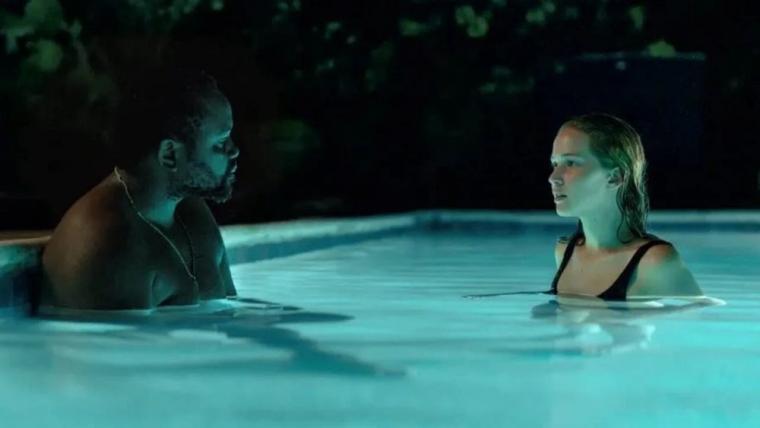
Among recent streaming titles I was most looking forward to, Apple TV+'s Causeway was high on my list, partly because I was psyched about seeing Jennifer Lawrence in the sort of low-key, human-scaled drama she hadn't done much of since 2010's Winter's Bone, and partly because I was psyched about seeing Brian Tyree Henry in anything. They're both good; director Lila Neugebauer's film is fine; I had to revisit the movie three separate times because I unintentionally kept falling asleep.
In this well-meaning, largely soporific work that evidently required three screenwriters (Ottessa Moshfegh, Luke Goeble, and Elizabeth Sanders), Lawrence plays an Army engineer whose traumatic brain injury from her service in Afghanistan has left her feeling isolated and alienated from friends and family. Henry plays an auto mechanic responsible for a car accident that left him with an amputated leg. These initial strangers bond during a therapy session; they start hanging out; they share booze and weed and the calm of the unmonitored swimming pools she cleans; they fight; they make up. That's pretty much it. So the only true engagement and investment Neugebauer's film offers has to come through the performances. Unfortunately for Causeway, Lawrence and Henry, excellent though they are, can't double-handedly jump-start this sedate, fundamentally unsatisfying character piece that keeps striving for broader themes, and more emotional connection, than it can ever amass. Still, whenever I remained conscious, I wasn't unhappy that I was watching it. Beyond the portrayals of Lawrence and Henry, there are terrific character turns by the too-rarely-seen Linda Emond, Jane Houdyshell, and Stephen McKinley Henderson, and the swimming pools photographed by cinematographer Diego Garcia are certainly inviting. You could argue that those pool scenes needed more (or livelier, or more incisive) dialogue. Yet who needs talk with hues that gorgeously blue?
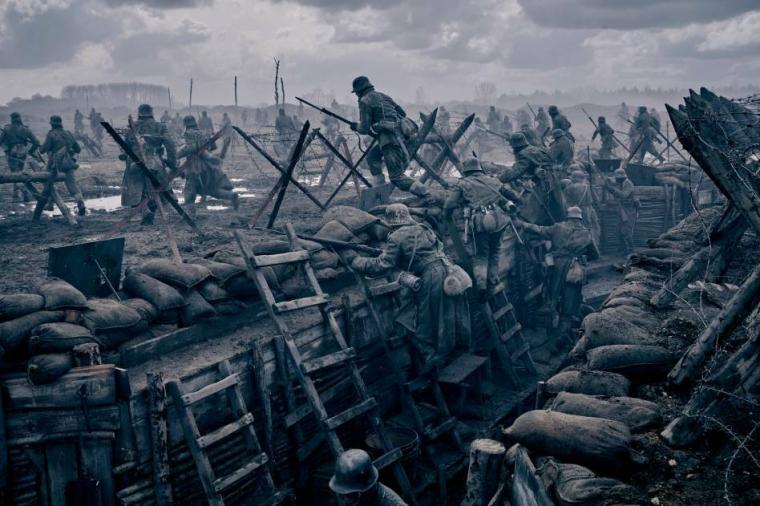
As mentioned, and in one of the perils of viewing streaming movies at night with the lights out, I accidentally conked out twice during Causeway viewings. The true mark of a first-rate streaming movie is one that you refuse to conk out for even when every fiber of your being is begging you to sleep. After a particularly long day of data-processing and other obligations this past weekend, I made the perhaps unwise decision to start watching All Quiet on the Western Front – writer/director Edward Berger's new, German-language adaptation of the classic Erich Maria Remarque novel – at around 9 p.m., knowing full well that the movie ran some two-and-a-half hours and was subtitled, to boot. By 10 o'clock, my body was screaming at me to give up, and I finally relented. But dammit, I awoke at 7 a.m. the next day to finish the thing, mostly because I was pissed that my viewing of this consistently arresting, heart-wrenching, profoundly violent anti-war epic was interrupted by something so stupid as a biological need for rest.
Set in 1917, Berger's film follows 17-year-old Paul Bäumer (Felix Kammerer) as he eagerly enlists in the first world war's German Army alongside school chums Albert Kropp (Aaron Hilmer), Franz Müller (Moritz Klaus), and Ludwig Behm (Adrian Grünewald), all of whom will inevitably, and fatally, understand the perils of war in ways their Fatherland-minded superiors never prepared them for. Even if you don't know or recall the story's particulars, you're likely familiar with its title, as it's a Mount Parnassus title – those six famed words not-so-subtly indicating that any decision to take the material on is a true fool's errand. (The 1930 film version won the third-ever Oscar for Best Picture, and aside from a 1979 TV-movie remake, this material, until now, has never been adapted for cinema since.) Yet Berger and his co-screenwriters Ian Stokell and Lesley Paterson prove more than up to the intimidating task. Their movie is brutally horrific, but never at the expense of character and nuance, and although there are momentary scenes of levity, nothing in it feels grandiose or saccharine. While the movie (photographed by cinematographer James Friend) is visually resplendent, it's not show-offy in the manner of Sam Mendes' WWI saga 1917, and while it's deeply moving, it's not manipulative in the manner of Spielberg's WWII tale Saving Private Ryan.
I understand that this praise might sound more like commending the movie for what it's not rather than what it is. But maybe you need to have seen a lot of war movies to recognize the honesty and, despite the genre's well-worn clichés, novelty of what Berger's All Quiet on the Western Front provides: deeply, recognizably human figures rather than types; gruesome viscera that feels connected to actual lives being lost and not as mood-altering visual effects; scenes of fear and panic and dogged survival instinct that feel decisively in-the-moment rather than telegraphed. I also can't think of a single war picture before this one that captured the heartbreaking truth of just how young nearly all soldiers of battle generally are. You look at the angelic faces of Kammerer's Paul and his equally revved-up friends and weep for the fates that only they don't see coming. Splendidly shot, hauntingly acted, and gripping from start to finish, All Quiet on the Western Front is consistently marvelous, as well as Germany's presumably deserved Academy Awards entry for this year's Best International Feature roster. Eventual Oscar or not, it's worthy of respect.










